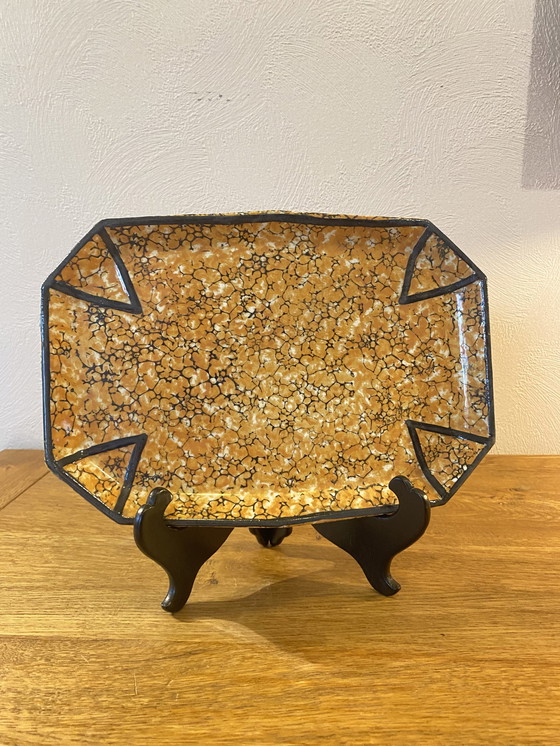Have it delivered hassle-freeBuyer protectionAll Designer items curated by WhoppahDownload the Whoppah App – get alerts & sell with ease.

Wasmule Ceramic Bowl
€90Bid from €75
Buy with confidence
Shop & pay safely with our Buyer ProtectionDesigner items curated by WhoppahWe only pay the seller once you have safely received the itemTrusted payment methods
About this seller
Hoegaarden, BelgiumOn Whoppah since April 2022 • 14 sales
Product description
Art Deco at its finest.
Handmade, hand painted, the color patina, the finish....
But the best thing about this dish is the color palette.
Dimensions : 20 x 29 cm - 3 cm high
The faïence factory of #Wasmuël.
In 1840 the "faïencerie de Wasmuël" was founded by Isodore Paulus 1798-1852 (son of Mathieu Joseph Paulus 1768-1830 who became former director of the faïencerie de Nimy in 1798). Isidore himself followed in his father's footsteps and became director of the French pottery factory of Onnaing at the outset in 1833.
In this small newly started factory of Wasmuël, mainly white glazed pottery containing tin was produced for domestic and sanitary use.
In 1850 Paulus began experimenting with majolica glazes and plain colored pottery ... soon after, these decorative wares were incorporated into the production line.
After his death in 1852, his wife, Joséphine Renau, succeeded him as business manager; she modernized production by purchasing a steam engine and further expanded the factory. For a quarter of a century the business ran splendidly ... but in the late 1970s it entered a downward spiral due to the industrialization crisis.
In 1878, the pottery industry in Europe collapsed completely.
Around 1878, Auguste Mouzin 1833-1899 (son of Jean-Pierre Mouzin ... then director of the faïencerie Nimy) and from Nimy, took over the management of this small factory. He himself had already established a faïencerie in Tergnier (France).
He systematically purchased surrounding land and erected new buildings ... the site
was even connected to the railroad network.
With seven large bottle kilns and a surface area of 4 ha, AMC was at that time one of the most important Belgian faience factories. It employed 200 people.
Surrounded by qualified personnel such as: François Dubois, Henri Mahieu, Emile Lombart, Arthur Ollinger, E Petit, Jean-Baptiste Tastenoe, Frédéric Thurner, Désiré Thon and others ... which moreover regularly engaged in job-hopping, the business expanded rapidly.
During this period, the factory also tried to make a name for itself abroad by participating in various exhibitions.
In 1893, France increased its import duties on luxury items, making the export of decorative ceramic objects from Belgium very difficult. They switched to the production of household pottery, toilet sets and mantel sets with clockwork.
After the death of Auguste Mouzin who took office as mayor of Wasmuël in 1890 and died in 1899, Eugène Meyer 1853-1907 (who was already working closely with August at the time) took over his father-in-law's thriving business and continued on the newly established path. The factory was given the status of a joint-stock company.
His son Henry 1885-1967 succeeded his father as manager in 1907 after his untimely death. During those forty-three years he went through several style transitions: eclecticism, art nouveau, art deco, bauhaus and so on. The decoration of objects evolved from the traditional handwork over transfer, spray and decalcomania techniques. The production of large ceramic decorative objects and ornaments came to an end at the beginning of the First World War.
After the Great War the fashion changed drastically, more and more everyday series products were produced with the highlights being cabinet sets in art deco style and animal figures in crackle. The 1937 participation in the Paris World's Fair was a great success ... Henry became a member of the "Légion d'Honneur.
During the Second World War, production was again reduced to the manufacture of domestic pottery ... for luxury pottery, unfortunately, there was no more room.
Due to the lack of raw materials and also the high longevity, the factory like many of its peers ran into major problems after the war.
Work ceased in 1951 and the factory was closed.
Specifications
ConditionExcellentColorsOrangeMaterialCeramicNumber of items1StyleVintageHeight3 cmWidth29 cmDepth20 cm
Discover more
Seller information
About this seller
Hoegaarden, BelgiumOn Whoppah since April 2022 • 14 sales















